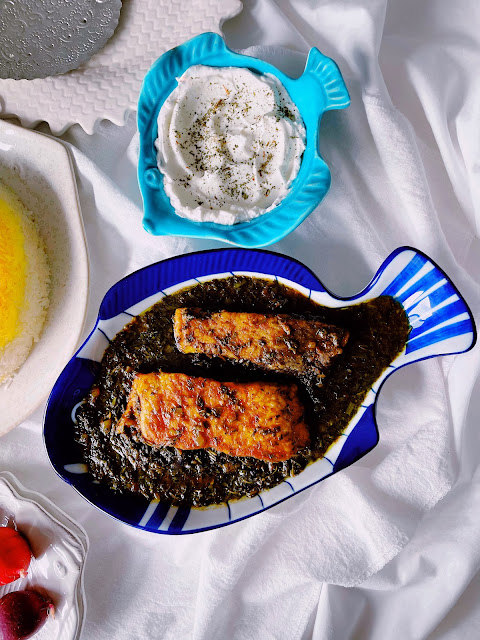I tried to stay true to the original recipe but I made a few changes. The original recipe called for the use of local Behshahr basil and since that's not available here, I simply substituted the regular basil. The recipe suggests the option of using mint instead of basil. Since both herbs add a burst of flavor and aroma to any dish I decided on using both, with basil as the main herb and half a bunch of mint and flat-leaf parsley. I love the taste of verjuice and in my teens I remember coming home from school and drinking a glass of verjuice. The recipe called for half a bottle (about 2 cups) of verjuice. This amount may be adjusted to your liking. I used about 1 1/2 cups of verjuice for all the ingredients to be fully infused with it, but it may not be evident in the picture. I only used half the amount of liquid before taking photos for the blog so that the texture of the eggplant, herbs and walnuts would show. The only ingredient that was not included in the recipe but that I chose to add was a touch of olive oil before serving to make it easier on the palate.

Naz Khatoon - Persian Eggplant & Herb Salad with Walnuts & Verjuice - Mazandarani-Style
Ingredients:
Serves 4-6
3 medium-large eggplants, preferably fire-roasted (I roasted them in the oven)
1 bunch basil, finely chopped, may use a combination of both purple and green basil (I only used green basil)
1/2 bunch flat-leaf parsley, finely chopped
1/2 bunch mint, finely chopped
2 garlic cloves, minced
1 teaspoon ground golpar (angelica powder)
1 cup walnuts, ground
1 tablespoon abghooreh (verjuice), add more if you prefer a more sour flavor
1-2 tablespoons olive oil *optional
Salt to taste
Method:
- Pierce the eggplant in several places with a fork. Place over medium-high fire on a stove or a grill until soft. If you are roasting the eggplant in the oven, place the pierced eggplant on a baking sheet and roast in a 400-degree Fahrenheit preheated oven for about 50 minutes or until fully cooked. Remove from the oven or the grill and allow to cool in a colander.
- Remove the skin and chop the eggplant finely.
- In a large bowl, combine chopped eggplant, basil, mint, parsley, garlic, and angelica powder. Add salt to taste.
- Pour the verjuice over the eggplant and herb mixture. Mix well. Taste and adjust the seasoning.
- Drizzle 1-2 tablespoons of olive oil over the salad.
- Sprinkle ground walnuts over the salad.
Serve in a bowl with rice (kateh-style), bread, and yogurt.
Enjoy!









